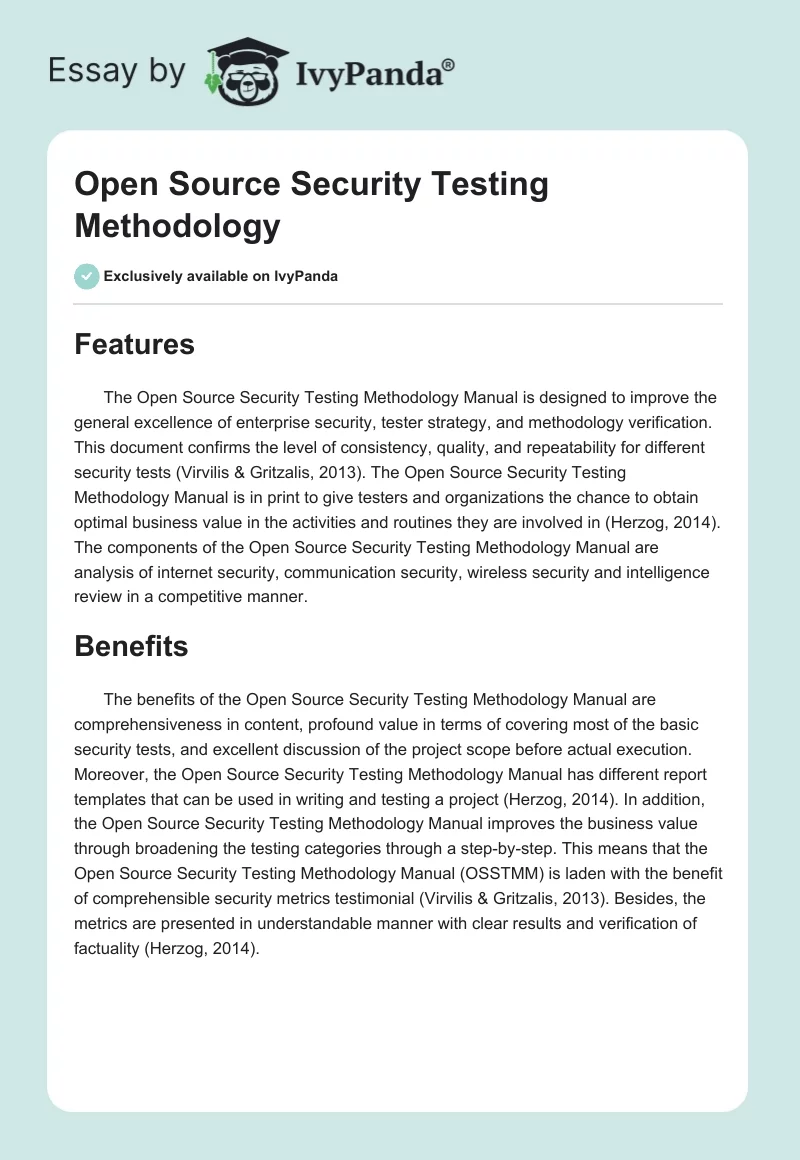Features
The Open Source Security Testing Methodology Manual is designed to improve the general excellence of enterprise security, tester strategy, and methodology verification. This document confirms the level of consistency, quality, and repeatability for different security tests (Virvilis & Gritzalis, 2013). The Open Source Security Testing Methodology Manual is in print to give testers and organizations the chance to obtain optimal business value in the activities and routines they are involved in (Herzog, 2014). The components of the Open Source Security Testing Methodology Manual are analysis of internet security, communication security, wireless security and intelligence review in a competitive manner.
Benefits
The benefits of the Open Source Security Testing Methodology Manual are comprehensiveness in content, profound value in terms of covering most of the basic security tests, and excellent discussion of the project scope before actual execution. Moreover, the Open Source Security Testing Methodology Manual has different report templates that can be used in writing and testing a project (Herzog, 2014). In addition, the Open Source Security Testing Methodology Manual improves the business value through broadening the testing categories through a step-by-step. This means that the Open Source Security Testing Methodology Manual (OSSTMM) is laden with the benefit of comprehensible security metrics testimonial (Virvilis & Gritzalis, 2013). Besides, the metrics are presented in understandable manner with clear results and verification of factuality (Herzog, 2014).
Penetration Testing Framework 0.59
Features
The Penetration Testing Framework 0.59 is one of the numerous methodologies available for testing network penetration. Specifically, the Penetration Testing Framework 0.59 outlines a step-by-step presentation of different tests for network penetration, especially in terms of the relevant tools for each test. Besides, the Penetration Testing Framework 0.59 outlines clear commands that can be applied in each testing tool (Virvilis & Gritzalis, 2013). The Penetration Testing Framework 0.59 as a network testing tool covers scanning, exploitation, and reconnaissance of the systems that are targeted (Lawson, 2014). Besides, it covers social engineering and specific technology for routers and wireless LAN.
Benefits
The benefits of the Penetration Testing Framework 0.59 are detailed focus on tests that analyze network penetration, provision of alternative and specific tools or commands for testing network penetration, and inclusion of different support tools such as Cisco, wireless LAN, and VoLP among others (Lawson, 2014). This means that there is an added layer of safety in a network since the Penetration Testing Framework 0.59 tests the vulnerability of a network.
Comparative Analysis: Similarities and Dissimilarities
The Open Source Security Testing Methodology Manual (OSSTMM) and Penetration Testing Framework 0.59 use similar approach in security testing. The two methods review consistency and vulnerability of different information technology tools. However, the OSSTMM is more comprehensive and multifaceted than the Penetration Testing Framework 0.59 (Virvilis & Gritzalis, 2013). The comparative analysis is summarized in the table below.
References
Herzog, P. (2014). OSSTMM: The Open Source Security Testing Methodology manual. Web.
Lawson, L. (2014). Penetration Testing Framework 0.59. Web.
Virvilis, N., & Gritzalis, D. (2013). Trusted computing vs. advanced persistent threats: Can a defender win this game? IEEE Autonomic and Trusted Computing, 5(4), 396-403.


